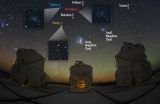Cosmic dust discs withstand hellfire
Astronomers at University of Bonn make a surprising discovery in the heart of our Milky Way Galaxy
2015-03-10
(Press-News.org) A team of scientists led by astronomers at the University of Bonn discovered an unusual phenomenon in the centre of the Milky Way: They detected about 20 rotating dust and gas discs in each cluster hosting exceptionally large and hot stars. The existence of these discs in the presence of the destructive UV radiation field of their massive neighbours came as a surprise. The science team is pondering how these rotating discs are able to withstand evaporation under these extreme conditions. The results are published in the most recent edition of the journal „Astronomy & Astrophysics".
The centre of the Milky Way is a nursery for young stars: In its very heart, more young stars are born in dark clouds than in any other place in the Galaxy. These stars form in rich groups such as the „Quintuplet" and „Arches" clusters which were the research focus of a science team under leadership of the University of Bonn's Argelander Institute for Astronomy. Both star clusters are merely a few million years young and contain stars as massive as 100 times the mass of the Sun. „We expected that the enormous radiative energy of these giant beasts evaporate the material around their smaller neighbours in less than one million years," says Dr. Andrea Stolte of the Argelander Institute for Astronomy at the University of Bonn.
Discovery of rotating discs contradicts theories of disc survival
Together with the Max-Planck-Institute for Astronomy, the Astronomical Calculation Institute of the University of Heidelberg and US-Colleagues located in Los Angeles, Honolulu, Dearborn and Baltimore, Dr. Stolte and her PhD students at the University of Bonn discovered an unexpected number of dusty discs surrounding stars in the „Quintuplet" and „Arches" clusters. „In such a hostile environment, we did not expect to find any circumstellar discs after more than a few hundred thousand years, and yet we found more than 20 discs in each cluster at ages of a few million years," says Dr. Stolte who coordinated the project. This surprising discovery contradicts the standard theories of disc survival in stellar nurseries and hints towards unrevealed processes taking place in these rich Galactic centre clusters.
The unexpected phenomenon could be observed with the European Southern Obervatory's (ESO) Very Large Telescope (VLT) in the Chilean Atacama desert and the Hubble Space Telescope (HST). „We would not have been able to glimpse through the dense layers of dust into the heart of the Milky Way with visual light," explains Dr. Maryam Habibi. It was the VLT's and HST's capability to capture infrared light that allowed the science team to penetrate deep into the core of our Galaxy. Dr. Habibi carried out her PhD thesis at the University of Bonn during the Emmy Noether project funded by the German Science Foundation (DFG).
Resistibility or a continuous supply of matter?
How these rotating discs survive the hellfire of their giant neighbours is puzzling. The astronomers considered two possibilities: Either the gas and dust discs display an unprecedented resistibility to their hostile environment, or a previously unobserved mechanism recharges the discs. The solution may lie in the companion stars. When two stars circle each other, the bigger companion may provide fuel to its smaller twin, possibly refueling disc material at a rate large enough to make up for the evaporated losses caused by the intense UV radiation surrounding the couple. Dr. Stolte considers the latter theory the most likely solution: „Many unknown processes take place in these rich, young star clusters. The tight interaction and mass flow between numerous close twins observed in other star-forming environments might also be the explanation for the dusty discs we found in these massive clusters."
Uncharted territory for planetary science
An even more unexpected possibility emerges with the presence of these discs, that was not considered possible in these extreme regions of the Milky Way: If dense discs of gas and dust are capable to survive for extended periods of time in this hostile environment, they may provide the conditions for planet formation. „If their is enough material - who knows?" asks Dr. Stolte. That, however, remains speculation. One way or the other - the heart of the Milky Way offers ample opportunities for unexpected discoveries from her astronomer's perspective.
INFORMATION:
Publication: Circumstellar discs in Galactic centre clusters: Disc-bearing B-type stars in the Quintuplet and Arches clusters, Astronomy & Astrophysics, DOI: 10.1051/0004-6361/201424132
Press release of the Max Planck Institute for Astronomy:
http://www.mpia.de/news/science/2015-02-dust-disks
[Attachments] See images for this press release:


ELSE PRESS RELEASES FROM THIS DATE:
2015-03-10
A new study from the University of Warwick is calling for more UK compulsory regulation of devices used in hip replacements to reduce the need for further traumatic and expensive surgery.
In a paper published today in the British Medical Journal, a team from Warwick Medical School looked at ten year revision rates for five of the most commonly used hip replacement devices. This means the number of devices that had to be replaced within 10 years of the original surgery.
The team found the revision rates for these devices were less than 5% but warned many other devices ...
2015-03-10
Genes linked with a greater risk of developing autism may also be associated with higher intelligence, a study suggests.
Researchers have found new evidence linking genetic factors associated with autism to better cognitive ability in people who do not have the condition.
The relationship between autism and intelligence is not clear, researchers say. Although up to 70 per cent of individuals with autism have an intellectual disability, some people with the disorder have relatively well-preserved, or even higher than average, non-verbal intelligence, the team says. ...
2015-03-10
It's called the gambler's fallacy: After a long streak of losses, you feel you are going to win. But in reality, your odds of winning are no different than they were before.
For years, the gambler's fallacy has been thought to be a prime example of human irrationality, but a new study published by researchers from the Texas A&M Health Science Center suggests that our brains naturally soak up the strange statistics of random sequences, causing us to commit the gambler's fallacy.
The study, which appears in the March 9 issue of the Proceedings of the National Academy ...
2015-03-10
It's not much harder or more expensive to send a tweet or a Facebook post to hundreds or even thousands of people than to just a handful. So you'd think that the ease of communicating with lots of people via social networks would result in more and more people sharing their thoughts, political views, and cat videos.
But that's not the case, says Associate Professor Zsolt Katona at UC Berkeley's Haas School of Business (pictured, left). The flood of tweets and posts washing across cyberspace has created a huge imbalance in the number of people creating content and the ...
2015-03-10
OTTAWA, March 10, 2015 - The younger a person is when they immigrate to Canada, the higher their risk of developing inflammatory bowel disease (IBD), and its major subtypes Crohn's disease and ulcerative colitis, according to a study by researchers at the University of Ottawa, the Institute for Clinical Evaluative Sciences (ICES) and the Children's Hospital of Eastern Ontario (CHEO). Canada has one of the highest rates in the world of IBD and while immigrants to Canada have lower rates of IBD compared to Canadian-born residents, that risk goes up in immigrants who are ...
2015-03-10
A team of astronomers from the University of Cambridge have identified nine new dwarf satellites orbiting the Milky Way, the largest number ever discovered at once. The findings, from newly-released imaging data taken from the Dark Energy Survey, may help unravel the mysteries behind dark matter, the invisible substance holding galaxies together.
The new results also mark the first discovery of dwarf galaxies - small celestial objects that orbit larger galaxies - in a decade, after dozens were found in 2005 and 2006 in the skies above the northern hemisphere. The new ...
2015-03-10
One of the most important areas in all of biology is the evolution of photosynthesis. Some species of single celled cyanobacteria, through photosynthesis, forever changed the atmosphere of the early Earth by filling it with oxygen, allowing a huge expansion in terms of what life was possible on the planet.
Cardona et al., in the advanced online edition of Molecular Biology and Evolution, examined the evolution origins of the D1 protein in cyanobacteria, which forms the heart of Photosystem II, the oxygen-evolving machine of photosynthesis. Photosystem II's role is to ...
2015-03-10
Researchers using the Karl G. Jansky Very Large Array (VLA) have produced the most detailed image yet of a fascinating region where clusters of hundreds of galaxies are colliding, creating a rich variety of mysterious phenomena visible only to radio telescopes.
The scientists took advantage of new VLA capabilities to make a "true color" radio image. This image shows the region as it would appear if human eyes were sensitive to radio waves instead of light waves. In this image, red shows where longer radio waves predominate, and blue shows where shorter radio waves predominate, ...
2015-03-10
As sailors and mountaineers know very well, every knot carries out a specific function. There's a knot that slides, one that "floats", and one that comes undone with a single pull. In the field of nanotechnology as well, it is useful to have several kinds of molecular knots to be used, for instance, as mechanically resistant nano-cages for delivering chemical compounds or for confining and controlling toxic reagents. So far, molecular knots have only been produced by chemical synthesis, obtaining constructs on an atomic scale. In the study coordinated by SISSA professor ...
2015-03-10
DENVER (March 10, 2015) - As branding and advertising creep into almost every facet of life, a new study from the University of Colorado Denver shows it's now making substantial inroads into popular music.
The study examined in detail the yearly top 30 Billboard songs from 1960 to 2013 - a total of 1,583 - and found a steep increase in `advertainment' or the use of product placement, branding and name dropping among the most popular music in the nation.
In 2006 alone, 20 of the top 30 songs, or two out of three, included at least one reference to a person, place or ...
LAST 30 PRESS RELEASES:
[Press-News.org] Cosmic dust discs withstand hellfire
Astronomers at University of Bonn make a surprising discovery in the heart of our Milky Way Galaxy



